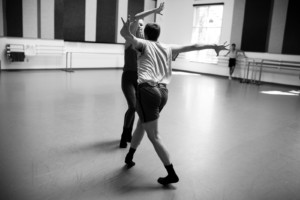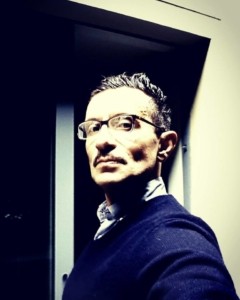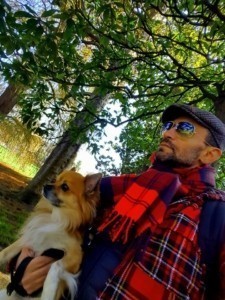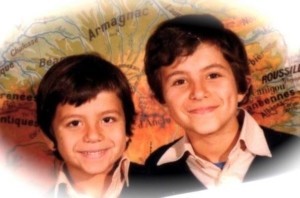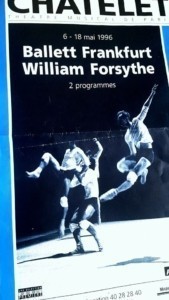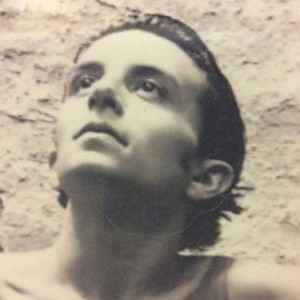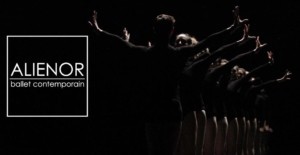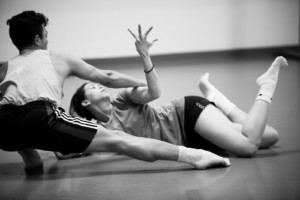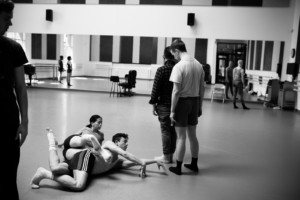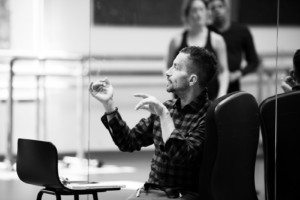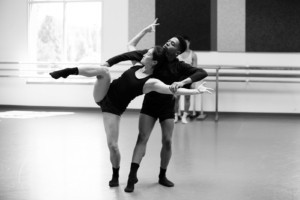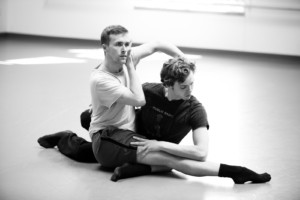As its core mission Whim W’Him is dedicated to high quality, original creations, bringing into being half a dozen or more new works each season, many from choreographers who have not worked with the company before. In committing to this vision of dance for Seattle, artistic director and principal choreographer Olivier Wevers, the 7 dancers, visiting choreographers and Whim W’Him audiences sign up for a fascinating, taxing, sometimes maddening, but ultimately magical experiment. In the words of French choreographer Pascal Touzeau, for each piece the dancers “have to give 100%—that’s 300%!” in the course of an evening.
Though each choreographer has a distinct style, many work in a vernacular that is at least somewhat familiar to Whim W’Him’s dancers. When they are collaborating with Olivier, naturally, no matter how new the specific material of the piece at hand, the dancers already speak his language and have an inkling of what to expect. Likewise, with a returning choreographer such as Annabelle Lopez Ochoa, who has often worked with the company: even for those who have joined since she last made a Whim W’Him piece, there’s knowledge of her modus operandi already in the air.
But the term ‘contemporary dance’ covers a multitude of approaches to movement and to creating new work. Occasionally a choreographer comes into the studio immersed in a different dance culture and speaking a quite foreign dance language. In a few short weeks s/he must teach a whole way of moving and conceiving of movement. The dancers must learn, not just as students but as accomplished spokespersons who have internalized the vocabulary, sentence structure and semantics (as it were) of the new language. By opening-night they need to be able to communicate like natives, captivating audiences with a finished piece. The current program,TRANSFIGURATE, opening June 8, 2018 at the Cornish Playhouse, is a double case in point. Both Pascal Touzeau and Danielle Agami* come out of full-fledged, integrated movement systems and very well-established dance institutions bolstered by many resources. Both choreographers also have their own current companies, where they work with dancers steeped in their respective traditions.
Originally of Bordeaux, France, Pascal Touzeau trained there in classical ballet at the Conservatoire de Bordeaux. His performance career began at l’Opéra de Bordeaux, Ballet Bonn and Ballet Wiesbaden. But one could say his most formative period was the time spent with William Forsythe in Frankfurt, Germany. As a Guardian article on the latter notes, Forsythe is “the only choreographer who has ever been mentioned in the same sentence as the philosopher Michel Foucault, applying a similar critical intelligence to the nature of dance and its language, asking people not just to watch dance, but to analyse what they are watching and understand how dancers themselves think, how steps are forged, how spaces, shapes and scores are created.” Forsythe himself says, “No one ever participated in the big conversation by saying the same thing over and over again. You have to see what is possible.” And it is this cerebral sensibility wedded to an exploratory attitude, that he has bequeathed to Pascal.
After a decade in Frankfurt, however, dancing and improvising for Forsythe and learning the trade of choreography, Pascal found—in a common trajectory for creative people—that he needed a change. The same Guardian article quotes Forsythe, “I had to find my way around Balanchine, Petipa, Cranko, MacMillan, the whole crowd. I realized I had to move on.” By the same token, says Pascal, “It was essential to detach myself from the strong answers and images and its being in my blood. At one point, in every piece I thought of [Forsythe’s] work. People compare, always, and it’s frustrating. But it’s a life-process. You’re always experimenting and try to take as much knowledge as possibly from everywhere and then expand creatively.”
In order to forge his own path, as dancer, and especially as choreographer, Pascal went to Spain where the Forsythe approach was little known and he himself could be open to new ideas and influences. His own approach and style blossomed while he served as associate director and choreographer at Ballet Carmen Roche and as ballet director and choreographer for Ballet Madrid, before returning to Germany as artistic director at Balletmainz (2009-2014). He stopped dancing when his choreographic and administrative demands grew too great. In 2011, Pascal was named Chevalier de l’Ordre des Arts et des Lettres of Franc, and for the past year now, he (along with co-director Christelle Lara) has headed a new company,Alienorballet, in his home town of Bordeaux.
For the past 3+ weeks, Pascal Touzeau has also been setting a brand-new piece on the Whim W’Him dancers, gambling on the Whim dancers’ ability to rise to the occasion. To continue the speech metaphor from above, one could say that, on multiple levels, the challenge for Pascal and Whim W’Him dancers alike has been a linguistic one, literally and figuratively. Pascal’s English is fluent, fluid. The words flow. But his mind is that of a European intellectual, steeped in principles internalized during his Forsythe decade, and consecrated to a sophisticated idea-based system of dance with which the Whim W’Him dancers have had little or no previous contact. He also approaches his work differently, focusing on details first, assembling phrases out of minute gestures and forms, linking phrases into sequences of movement and interaction. (I am reminded of the approach to piano pedagogy that requires students to spend long hours practicing scales and arpeggios and learning music theory before tackling any actual piece of music.)
Pascal’s approach is cerebral and verbal. I don’t believe I’ve ever witnessed a rehearsal quite like his first 3 hours in the studio, during which he spoke virtually non-stop to the dancers, with only a few demonstrations by him or illustrations using one or two of the dancers, for scant seconds at a time. Then and in subsequent rehearals, he spoke of “platforms” and “corridors,” terms to which he gives special meanings. Negotiating an expression like “the couronne” or “the contretemps” requires awareness of double or even triple meanings, finding a balance of between literal interpretations in English and French, the specific way a word is used in classical ballet, and its employment as a term of art particular to the Forsythe-inflected idiom of Pascal Touzeau. The dancers were attentive, sometimes amused (Pascal is a great mimic), and a good deal of the time pretty clearly perplexed.
Not surprisingly, this whole structure of thinking and approaching movement is immensely difficult to convey—in whatever vocal or bodily language—in a few short weeks, to dancers, even highly skilled ones, hitherto unversed in its intentions, definitions of terms, principles of movement, or demands on the body. If I said it is like asking a troupe of Western ballet dancers to internalize the principles of one of the eight forms of Indian classical dance and perform to a discerning audience within a month, I would be exaggerating, but not by a whole lot.
It is a complex, difficult, time-consuming and mesmerizing task. Furthermore, Pascal’s initial idea for the piece underwent a major transformation from a study of the inner workings of the mind to an abstract piece without overtly stated theme. In addition, the music now being used, a 20-minute movement from the 1971 of Russian composer Sofia Gubaidulina’s 1st string quartet, is dense, heavy and rhythmically complex. It must be meticulously counted (in 8s or 12s or 7s or 23, changing every few bars); sometimes cues be taken from other dancers’ movements rather than the sound of the music, which is not melodic in any ordinary sense. None of this has made an easy road for Pascal or the dancers to travel.
And yet from all the disorientation and struggle for mutual understanding, a new creation is being born that stretches all concerned into new and thought-provoking territory. Quite magically, even surprisingly, out of this difficult process riveting dance—electric, exact, unexpected, sculptural—is emerging, quite unlike anything Whim W’Him has presented before. Even the way the dancers hold their bodies and the angle of their heads is distinctive. While time may have been short to serve up a full, many-course banquet, spectators at this premiere will be treated to an exquisite entrée. From what I’ve seen this past week—and heard from Olivier, the dancers, and other observers—Pascal is winning his bet.
*A previous post (ducks sitting & Danielle Agami – Whim W’Him) touched on the challenges and rewards, for dancers and dance-maker alike, of working within Israeli-born and -trained choreographer Danielle Agami’s Gaga-based process.
Photo Credit: First image and last five by Bamberg Fine Art Photography
